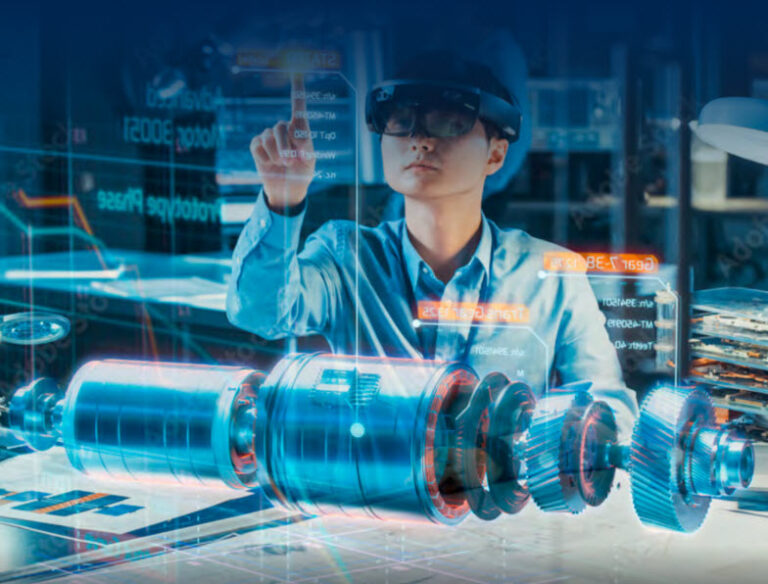Digital transformation remains a top priority for manufacturers in 2023. Yet, despite the movement entailing increased automation and less human intervention (in theory), manufacturing personnel are still essential to transformation. The paradox is that as more advanced manufacturing technologies are introduced, the more critical human employees become. They will be increasingly required to focus on value-added tasks, identify problems that need to be solved and continue driving the business forward.

However, data reveals a global shortage of skilled manufacturing workers, creating what is known as the manufacturing labor crisis. Let’s explore what this crisis entails and how it can be addressed and alleviated with the help of virtual technologies––specifically, Augmented reality (AR) and Virtual reality (VR).
The four dimensions of the manufacturing labor crisis
The U.S. National Association of Manufacturers found that 77% of manufacturers have ongoing difficulties attracting and retaining workers in 2021 and beyond. Moreover, finding the right talent is now 36% harder than in 2018, even though the unemployment rate has nearly doubled the supply of available workers.
Here, we have identified four main elements that create and amplify the manufacturing labor crisis:
- Experienced workers are leaving manufacturing in droves – driven by the retirement of more seasoned generations of workers and the “Great Resignation” associated with the COVID-19 pandemic.
- Manufacturers face great difficulty hiring replacements – lacking interest in manufacturing jobs is just one aspect of this dimension. In addition, many newer employees are noted to be ill-prepared for the expected work, as evidenced by high levels of turnover––as much as 50% of new hires leave before their six-month anniversary date.
- Replacements lack the expertise of past workers – even the best employers with robust training programs face the reality that new workers will likely never have the deep “tribal knowledge” of those experienced workers lost.
- Difficulties retaining and training new hires – on top of the high turnover rates, manufacturing jobs are becoming increasingly complex, high-skill and high-tech. This makes training and retaining manufacturing personnel more challenging and requires significant investment, which few manufacturers are willing to make.
The manufacturing labor crisis cannot be tackled by simply increasing wages, doubling down on hiring experienced workers, and making manufacturing positions more appealing to younger generations. Instead, in many cases, it requires redesigning your current plant operations and workforce training systems. The Manufacturing Institute found that “75% of industrial organizations identified reskilling the workforce as important or very important for their success over the next year”.
Companies will need the right technologies to support the evolving workforce, with a focus on enhancing training. Now, many manufacturers are looking to rearchitect training programs that incorporate the use of AR/VR.
The value of AR/VR in workforce training
Retaining and ensuring an engaged and operationally efficient workforce today means empowering them with the use of technology. AR/VR is a vital technology currently deployed to combat the manufacturing labor crisis.
It offers powerful immersive training to accelerate “door-to-floor” efforts, helping workers adapt to new technology by simulating new work environments. In addition, 3D models can be used with augmented reality to help close the skills gap created by the departure of more experienced employees.
Some advantages of 3D-driven training include:
- More realistic training experience that engages frontline personnel more directly and holistically
- Supports the development of skills that are difficult to impossible to explain verbally
- Eliminates the need to create physical mock-ups of control rooms, plant equipment or product sub-assemblies
- Accelerates learning and provides easy reinforcement mechanisms (train anywhere, immersive work instructions, etc.)
- Provides higher levels of trainee engagement
- Improves reusable learning content over time and across sites
Not only are AR/VR technologies becoming fundamental building blocks in the future of industrial work, but they are also “force multipliers” to accelerate digital transformation more generally. AR/VR enables new processes and operationalizes digital twin strategies, improves quality and manufacturing productivity, and accelerates new product introduction while providing immersive and intuitive technology to give feedback and close the digital twin loop.
The broader aim of such technologies is to create value for customers, meaningful work for people, and empower frontline workers to make decisions. This helps manufacturers become change-ready by reducing the burdens of technology adoption in frontline workers while blending advanced technology and digital dexterity with uniquely human skills for the highest level of decision support and productivity.
Download our white paper, The Impact of AR/VR Technology on the Manufacturing Labor Crisis to learn the real-life benefits of AR/VR in bridging the skills gap, accelerating digital transformation, and how Dassault Systèmes DELMIA solutions can equip your organization for change.

